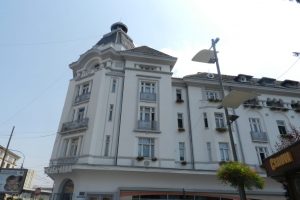

The bust was built up in the honor of Sima Pasaretz.
The dimensions of the bust: 55 x 70 cm.
Execution technique: founding – patina artificial stone.
The execution year: 2008.
The bust was executed by Tudorel Predan. Born on the date of the 16th of October 1958 in the locality Calafat, the county of Dolj, the artist chose to study art at the Art High School from Craiova, at the class of the professor Trifan Mihail, class of 1978.
Throughout the career his presented works in the private collection from Italy, Germany, France, the United States of America, Bulgaria, England, Canada, etc.
Sima Pasaretz: Among the first deputies chosen by the suburbs was Sima Pasaretz, who between the years 1866 – 1870 and 1879 also was the mayor of the city. Sima Pasaretz gave the city a modern aspect tracing the boulevard and the market, as we see them today, building up public buildings and executing fountains.
In the year 1869, there were taken measures for building the quarry, until that year it was as inexistent, the preliminary works for executing the quarry started in 1883 and they ended in 1885. At first, the bottom part of the quarry was built of wood, a few years later was replaced with stone. In 1905 there were loaded the following ships in the Port Calafat: 465 ships under Romanian pavilion, the most of them belonging to the state, 511 ships under Austrian pavilion, 114 Greek, 71 Bulgarian, 3 English, 1 French, 7 German, 9 Italian, 1 Ottoman, 62 Russian, 1 Serbian and 289 Hungarian.
The History of Calafat
The first pieces of history in the geographical space which outlined the municipality of Calafat and of the component villages – Basarabi, Golenți and Ciupercenii Vechi – they accentuated the existent of a steady population situated in the fireplace mentioned above of a oldest times, a population, with its own material and spiritual culture. The archeological research confirm the social differentiation in the IIIrd – Ist centuries b. Chr. and in the Ist century A.D., like the more and more active connections with the Balkan Roman origin, including by the passing point of the Danube near Calafat.
The first kept documentary research, regarding Calafat, dates back to the year 1424: the Customs from Calafat, which, in the centuries XV – XVI becomes the most important transit point for the commerce from Wallachia with the Balkan Peninsula.
The local legend
The local legend pleads for the idea that the ancient establishment of Calafat would have been at the origin a small fishermen colony. According to a legend, in the XIth century, more precisely between the years 1040 – 1042, a certain Mihail Calafat, master in the art of caulking, finding on these territories an adequate establishment for executing his work, would have founded, on the border of the Danube, a workshop for repairing and tarring ships, fact which made that the Byzantine navigators, and then the Genovese, attracted by his ability, to bring the ships to be repaired. According to the same legend, the unique place where the operation of caulking was made was the landing stage near this establishment which, later on, received the name of Calafat.





